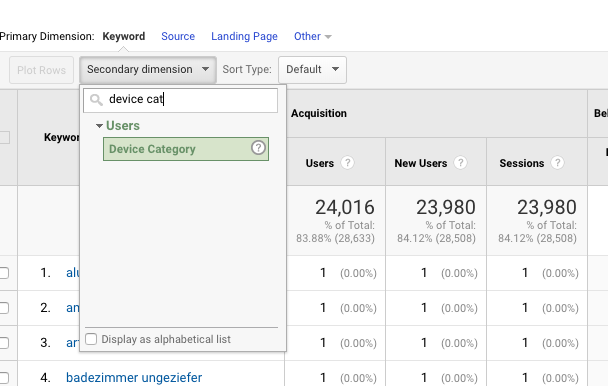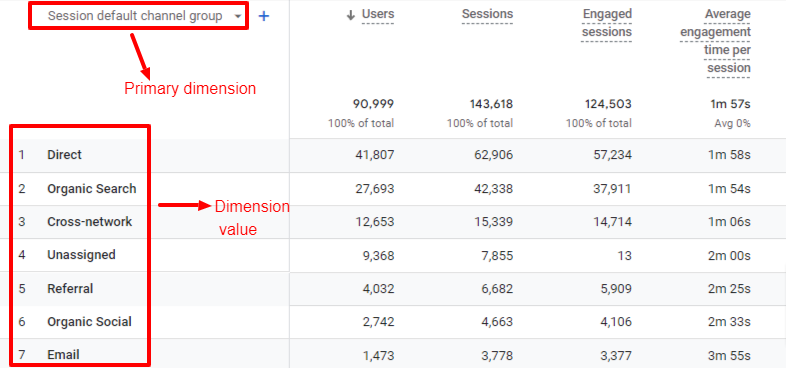Mastering Secondary Dimension in Google Analytics: A Total Guide
Wiki Article
Gain In-depth Perspectives With Second Dimension in Google Analytics
Additional dimensions in Google Analytics act as a powerful tool for enhancing the deepness of insights originated from information analysis. By including additional measurements right into your records, you open a world of possibilities for discovering detailed relationships and nuanced patterns within your site's efficiency metrics. This added layer of information can light up surprise trends and give a more granular understanding of customer actions. With the ability to section and contrast data throughout multiple measurements, the capacity for getting actionable understandings is large. Keep tuned to uncover exactly how secondary dimensions can revolutionize your information evaluation and drive informed decision-making in the digital world.Understanding Secondary Dimensions in GA
The concept of second dimensions in Google Analytics improves data analysis by supplying additional understandings right into primary metrics. Second dimensions allow users to dig much deeper into their information by adding an additional layer of information to the key information being examined. By incorporating second measurements, individuals can segment and compare information throughout different dimensions, such as traffic sources, user tools, geographical places, and more. This additional degree of granularity allows a more comprehensive understanding of user actions and web site performance.Recognizing just how to successfully utilize second dimensions in Google Analytics is crucial for extracting useful insights from the data gathered. By choosing the suitable second dimensions to match primary metrics, users can discover patterns, trends, and correlations that might have or else gone undetected. This deeper degree of evaluation can result in even more informed decision-making and the optimization of electronic advertising and marketing techniques to boost overall performance.
Advantages of Making Use Of Secondary Dimensions
Exploring the benefits fundamental in leveraging additional dimensions within Google Analytics illuminates the deepness of understandings available for enhancing data analysis. By integrating additional measurements, customers can gain a more thorough understanding of their primary data metrics. One of the essential benefits is the capacity to sector and filter information, permitting a more detailed evaluation of certain dimensions such as web traffic resources, user behavior, or geographical location - Secondary Dimension in Google Analytics. This segmentation helps in identifying patterns, patterns, and connections that may not be evident when considering the data in isolation.Additionally, second measurements make it possible for customers to compare and contrast different information factors within the exact same record, supplying a more holistic sight of website performance. This relative evaluation can clarify the performance of advertising and marketing projects, web content involvement, or individual demographics. Additionally, using second dimensions can help in recognizing outliers or anomalies that may require more examination.
Essentially, leveraging second dimensions in Google Analytics uses an effective device for extracting beneficial insights and enhancing data-driven decision-making processes.
Applying Secondary Dimensions Successfully
To successfully execute additional dimensions in Google Analytics, strategizing the selection and application of these added information layers is critical for taking full advantage of the deepness of understandings stemmed from analytics records. When picking secondary dimensions, take into consideration the specific goals of your analysis to make certain the chosen measurements align with the info required to address relevant concerns. It's necessary to prioritize significance over amount, picking measurements that complement the main measurement and give significant context.Carrying out second measurements efficiently entails utilizing them to reveal patterns, fads, and relationships that may not be obvious when analyzing information entirely based on the primary measurement. By incorporating secondary dimensions attentively, you can improve the granularity of your evaluation and gain deeper understandings right into user actions, content efficiency, and other vital metrics within Google Analytics.
Analyzing Information With Additional Measurements
Using secondary measurements in data evaluation offers a nuanced perspective that reveals complex connections and patterns within Google Analytics reports. By including additional dimensions together with key dimensions, experts can dig much deeper into the information to draw out valuable understandings. This approach enables the recognition of correlations that may not be right away apparent when evaluating information solely based upon key dimensions.When assessing information with second dimensions in Google Analytics, it is necessary to think about the details metrics check my source or measurements that will certainly supply the most purposeful context for the key dimension being analyzed. Matching the main measurement of 'web traffic resource' with additional measurements such as 'tool category' or 'landing page' can provide a much more thorough understanding of individual behavior and preferences.
Additionally, the ability to section information using secondary dimensions enables an extra granular assessment of user interactions, helping in the optimization of advertising and marketing approaches, site performance, and general individual experience. By leveraging additional measurements efficiently, organizations can make enlightened choices based upon a comprehensive analysis of their Google Analytics data.
Finest Practices for Second Dimensions
When applying secondary measurements in Google Analytics, precision in selecting pertinent metrics is vital for obtaining actionable understandings from the data evaluation procedure. Among the most effective practices for making use of second dimensions efficiently is to straighten them with your key measurement to get a much more comprehensive understanding of your internet site or campaign efficiency. For example, if your key dimension is 'Source/Medium,' matching it with secondary dimensions like 'Tool Category' or 'Touchdown Web page' can provide understandings into how different devices or landing web pages influence web traffic from different sources.
Consistently explore different mixes of primary and second dimensions can assist you discover new correlations and patterns within your information, allowing you to enhance your methods and enhance general performance (Secondary Dimension in Google Analytics). By adhering to these best methods, you can take advantage of secondary measurements in Google Analytics properly to gain deeper understandings and make data-driven decisions that positively influence your company

Verdict
Finally, secondary dimensions in Google Analytics give a beneficial possibility to acquire deeper understandings right into key information metrics. By including an additional measurement to reports, services can uncover relationships, patterns, and patterns that might not be immediately obvious, causing read the full info here a much more extensive understanding of user habits and communications on an internet site. Implementing additional dimensions properly and analyzing data with them can assist businesses make data-driven decisions and optimize their on the internet performance.By integrating second dimensions, users can sector and compare data throughout various dimensions, such as website traffic sources, user gadgets, geographical locations, and much more. Executing additional measurements properly involves using them to reveal patterns, patterns, and correlations that may not be noticeable when assessing data only based on the key measurement. By including secondary measurements along with primary dimensions, experts can delve much deeper into the data to extract useful understandings. One of the best methods for utilizing secondary measurements properly is to align them with your key measurement to obtain a much more comprehensive understanding of your web site or project efficiency. If your primary measurement is 'Source/Medium,' pairing it with second measurements like 'Tool Classification' or 'Touchdown Web page' can supply insights into just how various tools or touchdown pages impact traffic from different published here sources.
Report this wiki page